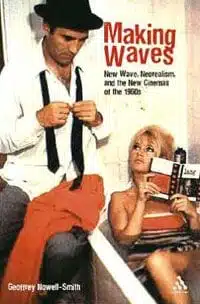
Geoffrey Nowell-Smith’s Making Waves: New Cinemas of the 1960s is a brief and concise overview of a complex era. Its inflated paperback price ($21.95), instructional academic tone, and careful insistence on covering current analytical theory implies that its primary use is for an undergraduate film criticism course. It doesn’t have any revisionist pretensions. But while useful as a primer, this slim volume leaves out so much I sometimes wondered what it hopes to accomplish.
In the introduction, Nowell-Smith analyzes various conceptions of the ‘60s (which for his purposes he defines as the mid-‘50s to mid-‘70s), general world historical trends, and announces that it will analyze the period from the “liberationist narrative” as opposed to the “narrative of modernization”. Thankfully, having defined the author’s point-of-view and set the theoretical stage for what is to follow, this is about as semantically obtuse as Nowell-Smith gets.
The introduction also features an apology of sorts for the book’s greatest fault: the heavy focus on western European films. “If this is Eurocentrism, all I can plead is guilty with mitigation.” His reasoning is that, “I am dependent on what I know or have been able easily to find out.” But this isn’t much of an excuse. The current availability of film through videos and DVDs and online and physical archives, while by no means thorough or complete, at least makes it easy to have a working knowledge of the major directors and their major works. Film scholars should be using these resources to deepen our knowledge of less familiar films while drawing a more comprehensive portrait of movements and eras, not re-analyzing the French and Italian pantheon.
The only Japanese director discussed is Nagisa Oshima. The section on Latin America delves into post-Castro Cuban cinema but at the expense of any thoroughness on Brazil. While the scant coverage of mainstream American cinema is understandable (generally marked by the studios’ fumbling transition from The Sound of Music to Easy Rider), the American underground — Andy Warhol, Stan Brakhage, Shirley Clarke, John Cassavetes, and Kenneth Anger — are unfathomably ignored.
This is unfortunate, because there is still a lot of unexplored territory in ‘60s cinema. The major film movements of the decade are not as weighed down by the mythomania and overworked platitudes surrounding the other cultural media like music and television. Many of the questions posed in their post-modern analysis of film language are still crucial and are being explored by the filmmakers of today. It would be interesting to know how the “liberationist narrative” played out over a wider and more complicated swathe of global cultures.
The meat of the book is broken up into three main sections. Each highlights a different approach to film analysis while developing the various ideas in relation to one another. The first discusses the era by subject matter and technology: sex, politics, nationalism, cinema verite, narrative methods, and innovations in the camera. The second details five film movements in Britain, France, Italy, Eastern Europe, and Latin America. And the final takes the auteur approach, dissecting the works of Jean-Luc Godard, Michelangelo Antonioni, and Pier Paolo Pasolini.
Some of the information is overly broad for my taste. I don’t really need a description of what constitutes a narrative. But Nowell-Smith has a knack for concise historical sketches peppered with insightful details. Particular highlights are the descriptions of how the Éclair NPR camera and Nagra III-B tape recorder revolutionized documentary filmmaking, the role commercially successful crime genre films played in launching France’s Nouvelle Vague, and how Soviet satellite politics effected film movements in Poland, Czechoslovakia, and Yugoslavia. Overall the “Movements” section is the most inclusive, gathering and relating historical, technical, sociological, biographical, thematic, aesthetic and economic information in a way that the central points are never obscured, simplified, or dulled through over analysis.
Though soberly British, Nowell-Smith’s no-nonsense tone is enlivened by the occasional catty aside. He calls out a line of books by the publisher Routledge, “in which the vexatious question of what is meant by the term ‘national cinema’ is addressed at best sketchily and in some cases not at all.” On censorship he says: “It tended to be assumed in European films that human beings were born with sexual organs and at a certain point in their lives began to use them, not always in socially approved ways. (These were known facts in the USA as well, but the PCA [Production Code Administration] did its best to disguise them.)”
As an orientation course, Making Waves is brisk and condensed, more likely to pique the reader’s curiosity rather than leave them oversaturated, bewildered, and frustrated by arcane academia or a dense compendia of references. The Index of Film Titles in the back makes it easy to mark and then track down films and directors while reading the text. And the bibliography is a comprehensive collection of entertaining and scholarly books and articles that expand on what is written, with authors including André Bazin, Jonas Mekas, Susan Sontag, and Josef Škvorecký. Its lucid and well-structured prose makes it a suitable addition to any student’s reading list. Unfortunately it doesn’t offer enough new information to warrant the attention of anyone already familiar with the era.
